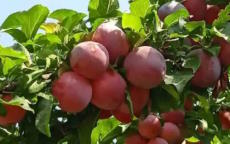Apricot trees
Melitopolski Cherny
Melitopolski Cherny is a dark red hybrid apricot / cherry plum which ripens in mid-July, also known as a Black Apricot.- Picking season: Early
- Self-fertility: Partially self-fertile
Mia®
Mia is an apricot variety well-suited to growing in the cooler climates of northern Europe.- Picking season: Late
- Self-fertility: Not self-fertile
Polonais
Polonais is one of the most cold-hardy of all apricots, and a good choice for growing in northern Europe.- Picking season: Early
- Self-fertility: Self-fertile
Precoce de Saumur
Precoce de Saumur is an early-season apricot with good cold-hardiness.- Picking season: Early
- Self-fertility: Self-fertile

